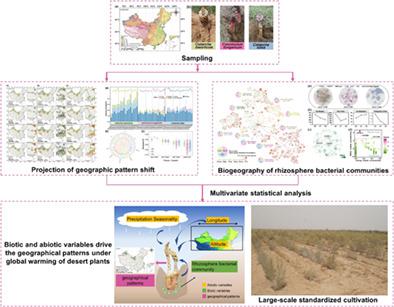当前位置:
X-MOL 学术
›
Environ. Microbiol.
›
论文详情
Our official English website, www.x-mol.net, welcomes your
feedback! (Note: you will need to create a separate account there.)
Fighting climate change: soil bacteria communities and topography play a role in plant colonization of desert areas
Environmental Microbiology ( IF 4.3 ) Pub Date : 2021-10-24 , DOI: 10.1111/1462-2920.15799 Xiao Sun 1 , Jin Pei 2, 3 , Lei Zhao 4 , Bashir Ahmad 5 , Lin-Fang Huang 1
Environmental Microbiology ( IF 4.3 ) Pub Date : 2021-10-24 , DOI: 10.1111/1462-2920.15799 Xiao Sun 1 , Jin Pei 2, 3 , Lei Zhao 4 , Bashir Ahmad 5 , Lin-Fang Huang 1
Affiliation

|
Global warming has exacerbated desertification in arid regions. Exploring the environmental variables and microbial communities that drive the dynamics of geographic patterns of desert crops is important for large-scale standardization of crops that can control desertification. Here, predictions based on future climate data from CMIP6 show that a steady expand in the suitable production areas for three desert plants (Cistanche deserticola, Cynomorium songaricum and Cistanche salsa) under global warming, demonstrating their high adaptability to future climate change. We examined the biogeography of three desert plant soil bacteria communities and assessed the environmental factors affecting the community assembly process. The α-diversity significantly decreased along elevated latitudes, indicating that the soil bacterial communities of the three species have latitude diversity patterns. The neutral community model evaluated 66.6% of the explained variance of the bacterial community in the soil of desert plants and Modified Stochasticity Ratio <0.5, suggesting that deterministic processes dominate the assembly of bacterial communities in three desert plants. Moreover, topography (longitude, elevation) and precipitation as well as key OTUs (OTU4911: Streptomyces eurythermus and OTU4672: Streptomyces flaveus) drive the colonization of three desert plants. This research offers a promising solution for desert management in arid areas under global warming.
中文翻译:

应对气候变化:土壤细菌群落和地形在沙漠地区的植物定植中发挥作用
全球变暖加剧了干旱地区的荒漠化。探索驱动沙漠作物地理格局动态的环境变量和微生物群落对于控制荒漠化的作物的大规模标准化非常重要。在这里,基于 CMIP6 未来气候数据的预测表明,三种沙漠植物(肉苁蓉、锁阳和莎莎肉苁蓉)的适宜产区稳步扩大) 在全球变暖的情况下,展示了它们对未来气候变化的高度适应能力。我们检查了三个沙漠植物土壤细菌群落的生物地理学,并评估了影响群落组装过程的环境因素。α-多样性随着纬度的升高而显着降低,表明这三个物种的土壤细菌群落具有纬度多样性模式。中性群落模型评估了沙漠植物土壤中细菌群落解释方差的 66.6%,修正随机比 <0.5,表明确定性过程主导了三种沙漠植物中细菌群落的组装。此外,地形(经度、海拔)和降水以及关键 OTU(OTU4911:Streptomyces eurythermus和 OTU4672:Streptomyces flaveus ) 推动了三种沙漠植物的定殖。这项研究为全球变暖下干旱地区的沙漠管理提供了一个有前景的解决方案。
更新日期:2021-11-26
中文翻译:

应对气候变化:土壤细菌群落和地形在沙漠地区的植物定植中发挥作用
全球变暖加剧了干旱地区的荒漠化。探索驱动沙漠作物地理格局动态的环境变量和微生物群落对于控制荒漠化的作物的大规模标准化非常重要。在这里,基于 CMIP6 未来气候数据的预测表明,三种沙漠植物(肉苁蓉、锁阳和莎莎肉苁蓉)的适宜产区稳步扩大) 在全球变暖的情况下,展示了它们对未来气候变化的高度适应能力。我们检查了三个沙漠植物土壤细菌群落的生物地理学,并评估了影响群落组装过程的环境因素。α-多样性随着纬度的升高而显着降低,表明这三个物种的土壤细菌群落具有纬度多样性模式。中性群落模型评估了沙漠植物土壤中细菌群落解释方差的 66.6%,修正随机比 <0.5,表明确定性过程主导了三种沙漠植物中细菌群落的组装。此外,地形(经度、海拔)和降水以及关键 OTU(OTU4911:Streptomyces eurythermus和 OTU4672:Streptomyces flaveus ) 推动了三种沙漠植物的定殖。这项研究为全球变暖下干旱地区的沙漠管理提供了一个有前景的解决方案。











































 京公网安备 11010802027423号
京公网安备 11010802027423号